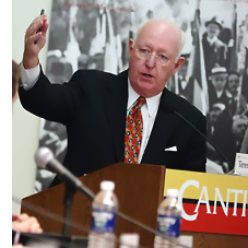Two of the best practitioners of the English language died this week: William F. Buckley Jr. and W.C. Heinz.
They could not have been more different writers.
Bill Buckley delighted in the complexities of the language; his erudite phrasing was over-the-top, but entertaining. Often he was just trying to score points over one of his adversaries on Firing Line. One of his favorite responses was: “I won’t insult your intelligence by suggesting that you actually believe what you are saying.”
Bill Heinz sought the simplicity of the language. As a newspaper reporter, distinguished war correspondent, sports columnist, freelance journalist and novelist, he wrote clean, spare prose, always trying to get to the essence. Hemingway was his hero and literary model. Once, when he had all but exhausted himself in writing a novel, his doctor told him: “Bill, if you don’t stop trying to be the greatest writer in the world, you’re going to kill yourself.” “I’m not trying to be the greatest writer in the world,” Bill answered. “I’m just trying to be the best writer I can be.”
In August, 2004, I spent an afternoon with Buckley at his lovely home overlooking Long Island Sound in Stamford, Connecticut. I’d come with a producer and camera crew from The NewsHour with Jim Lehrer to interview him about his decision to step down from the National Review. I was there on business, but Buckley could not have been more gracious and welcoming. He showed us around, invited us to share lunch, played his harpsichord for us and acted as though there was nothing he would rather do with his afternoon.
Buckley had converted an adjacent barn into an office. In the middle, all-but-hidden by memorabilia and books and files and clutter, was his computer. He was going to continue writing his newspaper column, he said, because it gave him three kinds of satisfaction. “One is creating something, one is being paid for it, and one is the feeling that I haven’t just been sitting on my ass all afternoon.”
Bill Heinz was an equally gracious host. He was a close friend of my father, the late sports columnist Red Smith, and I grew up listening to the two of them trade stories in the Heinz home or ours. My father recalled one time when he was in Cuba visiting Bill’s literary hero at his Finca Vigia, just outside Havana. Hemingway had just read Bill’s first novel, The Professional, about a prize fighter, and was full of praise for it.
“But damn,” Hemingway said of the main character, “I didn’t want Bill’s fighter to lose.” “You didn’t want him to lose?” my father said, incredulously. “How about Bill? When he started the book, he knew how he had to end it. But after he wrote the first line leading into the fight, he had to take a day off and walk in the woods to get up the courage to have his fighter knocked out.”
For Bill Heinz, writing was a contact sport.
